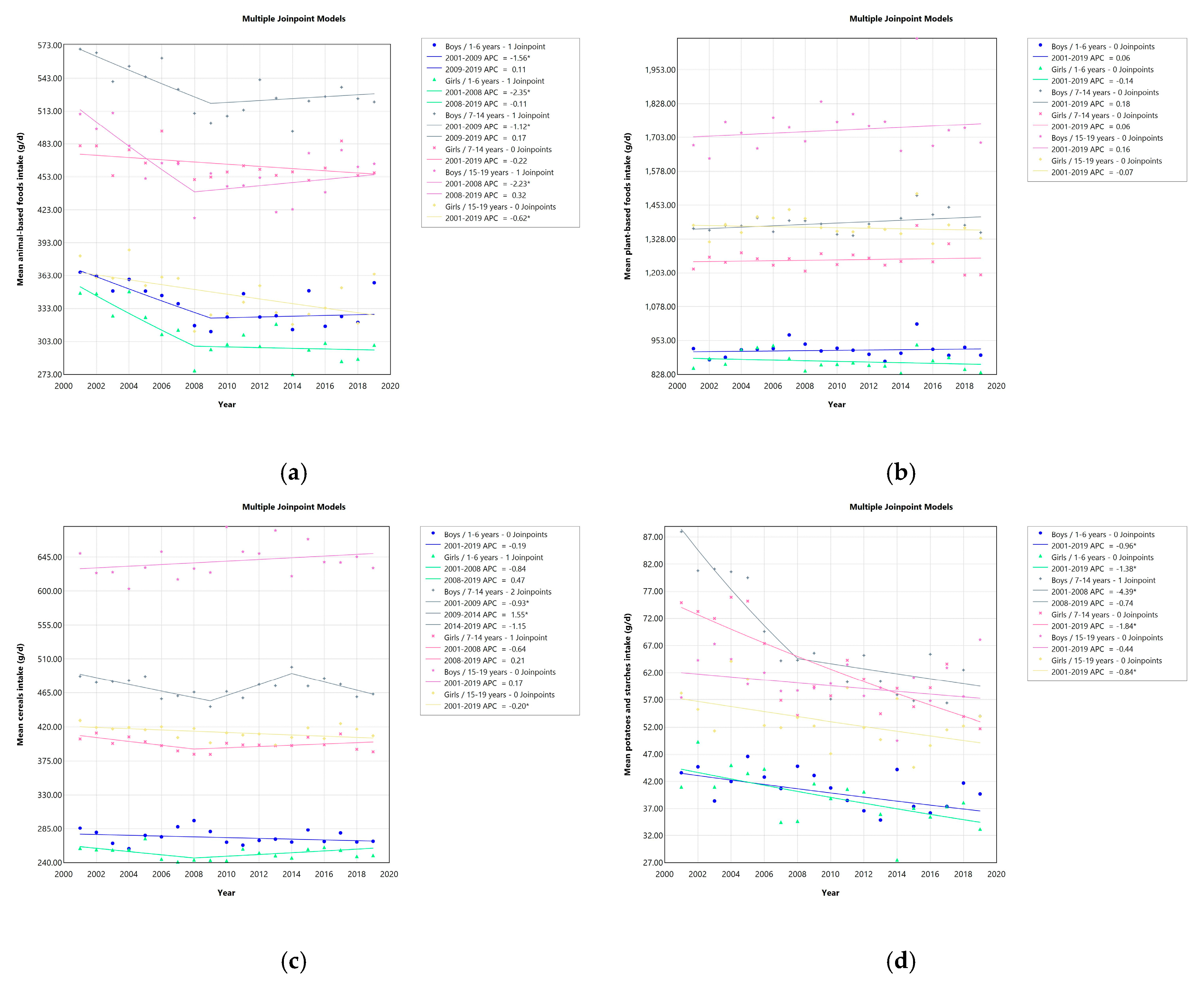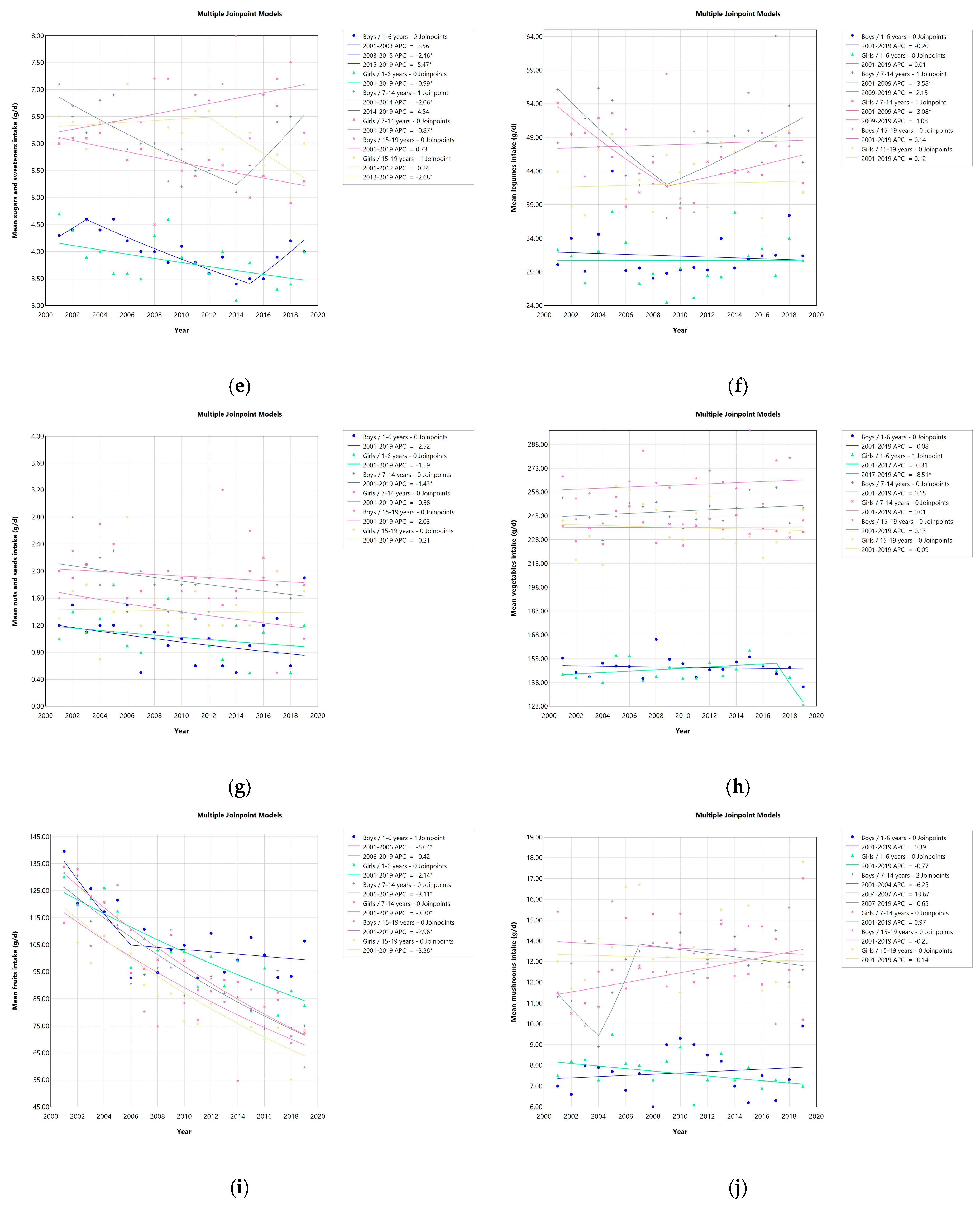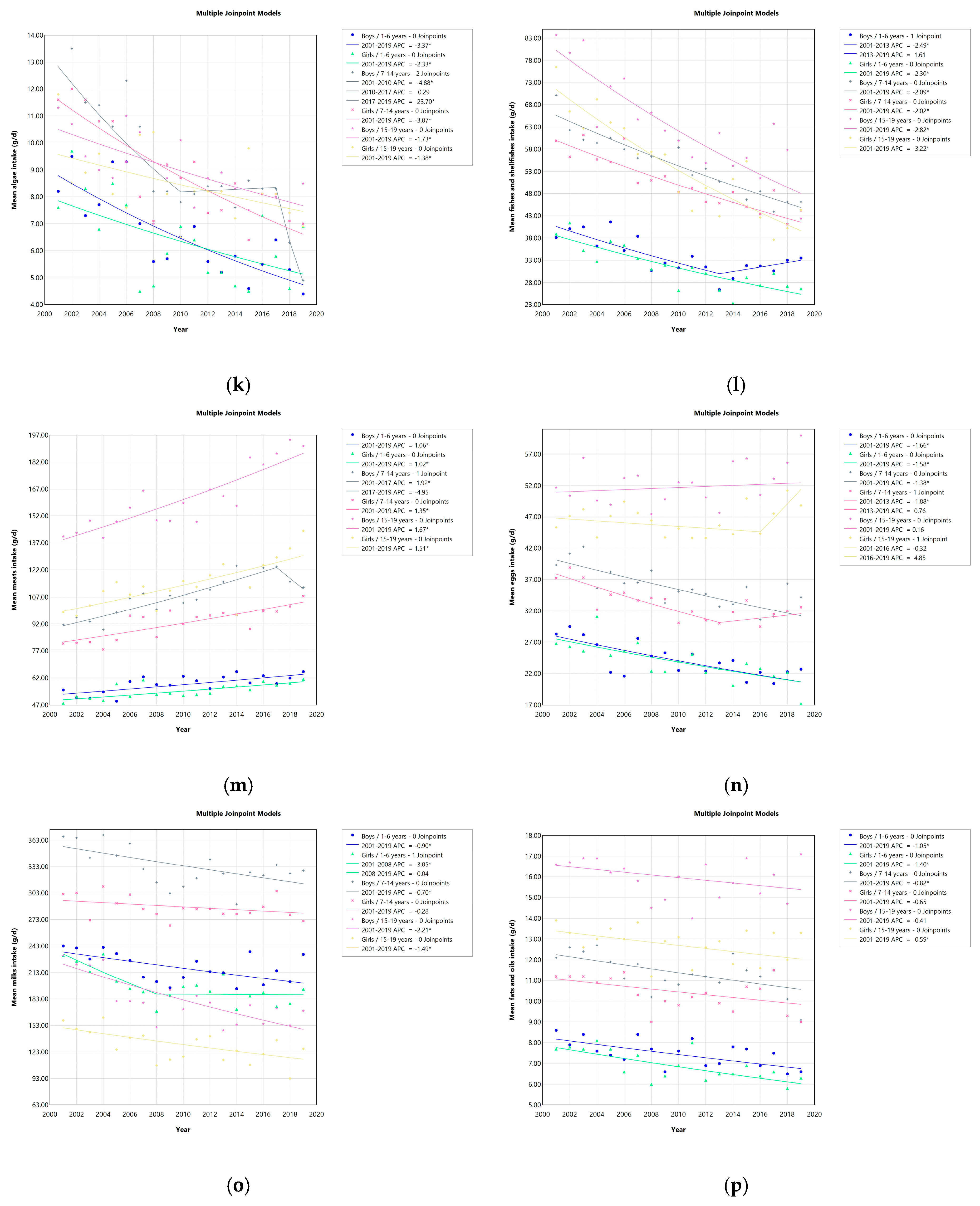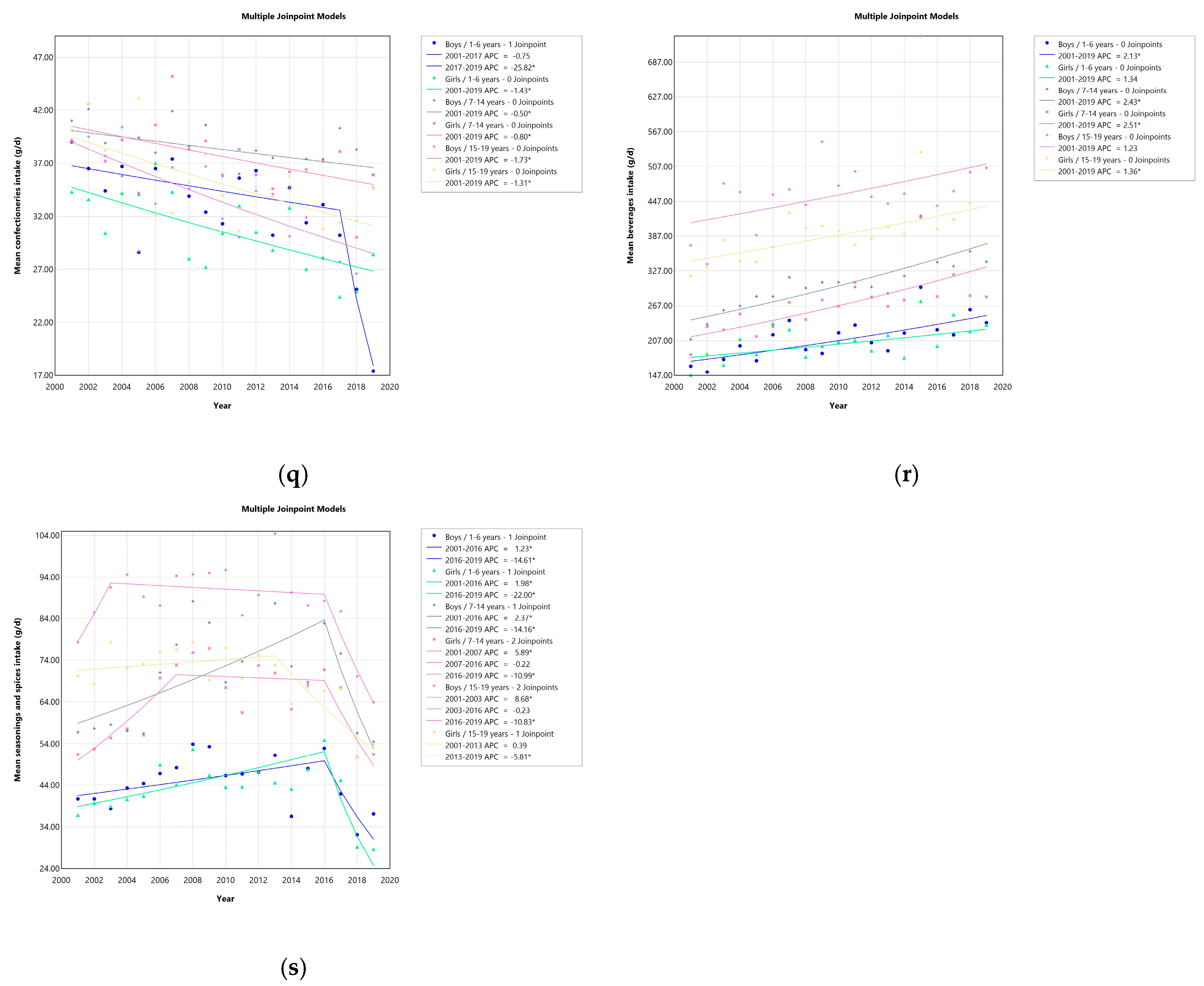Food Consumption Trends in Japanese Children and Adolescents: The National Health and Nutrition Survey, 2001–2019
Abstract
1. Introduction
2. Materials and Methods
2.1. Study Design
2.2. Dietary Assessment
2.3. Statistical Analysis
3. Results
4. Discussion
5. Conclusions
Supplementary Materials
Author Contributions
Funding
Institutional Review Board Statement
Informed Consent Statement
Data Availability Statement
Conflicts of Interest
References
- Okada, E.; Okada, C.; Matsumoto, M.; Takimoto, H. Regional Trends in Dietary Intake in Japan: The 2003~2017 National Health and Nutrition Survey. Jpn. J. Nutr. Diet. 2020, 78, S16–S26. [Google Scholar] [CrossRef]
- Matsumoto, M.; Tajima, R.; Fujiwara, A.; Yuan, X.; Okada, E.; Takimoto, H. Trends in Food Group Intake According to Body Size among Young Japanese Women: The 2001–2019 National Health and Nutrition Survey. Nutrients 2022, 14, 4078. [Google Scholar] [CrossRef] [PubMed]
- Ishikawa, M.; Eto, K.; Haraikawa, M.; Yoshiike, N.; Yokoyama, T. Relationship between parents’ dietary care and food diversity among preschool children in Japan. Public. Health Nutr. 2022, 25, 398–409. [Google Scholar] [CrossRef]
- Shinozaki, N.; Murakami, K.; Kimoto, N.; Masayasu, S.; Sasaki, S. Highly Processed Food Consumption and its Association With Overall Diet Quality in a Nationwide Sample of 1318 Japanese Children and Adolescents: A Cross-Sectional Analysis Based on 8-Day Weighed Dietary Records. J. Acad. Nutr. Diet. 2025, 125, 303–322.e305. [Google Scholar] [CrossRef]
- Ministry of Education, Culture, Sports, Science and Technology, Japan. Promotion of Shokuiku (Food and Nutrition Education) in Schools and Enhancement of School Lunches. Available online: https://www.mext.go.jp/content/20230920-mxt_kenshoku-000008678_2.pdf (accessed on 21 December 2022). (In Japanese)
- Ishida, H. The History, Current Status, and Future Directions of the School Lunch Program in Japan. Jpn. J. Nutr. Diet. 2018, 76, S2–S11. [Google Scholar] [CrossRef]
- Asakura, K.; Sasaki, S. School lunches in Japan: Their contribution to healthier nutrient intake among elementary-school and junior high-school children. Public. Health Nutr. 2017, 20, 1523–1533. [Google Scholar] [CrossRef]
- Yoshiike, N.; Hayashi, F.; Takemi, Y.; Mizoguchi, K.; Seino, F. A new food guide in Japan: The Japanese food guide Spinning Top. Nutr. Rev. 2007, 65, 149–154. [Google Scholar] [CrossRef]
- United Nations Children’s Fund. The State of the World’s Children 2019: Children, Food and Nutrition: Growing Well in a Changing World; United Nations Children’s Fund: New York, NY, USA, 2019. [Google Scholar]
- World Health Organization. Healthy diet. 2020. Available online: https://www.who.int/news-room/fact-sheets/detail/healthy-diet (accessed on 13 February 2024).
- Ministry of Health, Labour and Welfare. National Health and Nutrition Survey. Available online: https://www.mhlw.go.jp/bunya/kenkou/kenkou_eiyou_chousa.html (accessed on 14 December 2022). (In Japanese)
- Yoshiike, N.; Matsumura, Y.; Iwaya, M.; Sugiyama, M.; Yamaguchi, M. National Nutrition Survey in Japan. J. Epidemiol. 1996, 6, S189–S200. [Google Scholar] [CrossRef]
- Ikeda, N.; Takimoto, H.; Imai, S.; Miyachi, M.; Nishi, N. Data Resource Profile: The Japan National Health and Nutrition Survey (NHNS). Int. J. Epidemiol. 2015, 44, 1842–1849. [Google Scholar] [CrossRef]
- National Institute of Health and Nutrition. National Health and Nutrition Survey—Health Japan 21 Analysis and Assessment Project. Available online: https://www.nibiohn.go.jp/eiken/kenkounippon21/en/eiyouchousa/index.html (accessed on 11 November 2024).
- Ministry of Education, Culture, Sports, Science and Technology. Standard Tables of Food Composition in Japan, Fifth ed.; Ministry of Education, Culture, Sports, Science and Technology: Tokyo, Japan, 2005. (In Japanese)
- Ministry of Education, Culture, Sports, Science and Technology. Standard Tables of Food Composition in Japan, Fifth Revised and Enlarged ed.; Ministry of Education, Culture, Sports, Science and Technology: Tokyo, Japan, 2005. (In Japanese)
- Ministry of Education, Culture, Sports, Science and Technology. Standard Tables of Food Composition in Japan; Ministry of Education, Culture, Sports, Science and Technology: Tokyo, Japan, 2010. (In Japanese)
- Ministry of Education, Culture, Sports, Science and Technology. Standard Tables of Food Composition in Japan, Seventh Revised Version; Ministry of Education, Culture, Sports, Science and Technology: Tokyo, Japan, 2015. (In Japanese)
- Ministry of Health, Labour and Welfare. Report of the National Health and Nutrition Survey in Japan. 2019; (In Japanese). Available online: https://www.mhlw.go.jp/stf/seisakunitsuite/bunya/kenkou_iryou/kenkou/eiyou/r1-houkoku_00002.html (accessed on 3 February 2022).
- National Cancer Institute. Joinpoint Trend Analysis Software. Available online: https://surveillance.cancer.gov/help/joinpoint/joinpoint-5-0-default-settings-changes (accessed on 4 April 2025).
- World Health Organization, Food and Agriculture Organization of the United Nations. Sustainable Healthy Diets: Guiding Principles. 2019. Available online: https://www.who.int/publications/i/item/9789241516648 (accessed on 12 February 2024).
- Okubo, H.; Sasaki, S.; Murakami, K.; Kim, M.K.; Takahashi, Y.; Hosoi, Y.; Itabashi, M. Three major dietary patterns are all independently related to the risk of obesity among 3760 Japanese women aged 18–20 years. Int. J. Obes. 2008, 32, 541–549. [Google Scholar] [CrossRef]
- Asakura, K.; Masayasu, S.; Sasaki, S. Dietary intake, physical activity, and time management are associated with constipation in preschool children in Japan. Asia Pac. J. Clin. Nutr. 2017, 26, 118–129. [Google Scholar] [CrossRef] [PubMed]
- Kim, H.; Caulfield, L.E.; Rebholz, C.M.; Ramsing, R.; Nachman, K.E. Trends in types of protein in US adolescents and children: Results from the National Health and Nutrition Examination Survey 1999–2010. PLoS ONE 2020, 15, e0230686. [Google Scholar] [CrossRef] [PubMed]
- Ministry of Agriculture, Forestry and Fisheries. Preservation and Inheritance of Washoku. Available online: http://www.maff.go.jp/j/keikaku/syokubunka/culture/ (accessed on 2 May 2024). (In Japanese)
- Ministry of Agriculture, Forestry and Fisheries. Washoku. Traditional Dietary Cultures of the Japanese. Available online: http://www.maff.go.jp/e/data/publish/attach/pdf/index-20.pdf (accessed on 2 May 2024).
- Tester, J.M.; Leung, C.W.; Leak, T.M.; Laraia, B.A. Recent Uptrend in Whole-Grain Intake Is Absent for Low-Income Adolescents, National Health and Nutrition Examination Survey, 2005–2012. Prev. Chronic. Dis. 2017, 14, E55. [Google Scholar] [CrossRef] [PubMed]
- Ministry of Health, Labour and Welfare. Healthy Japan 21 (Third Phase). Available online: https://www.mhlw.go.jp/stf/seisakunitsuite/bunya/kenkou_iryou/kenkou/kenkounippon21_00006.html (accessed on 13 February 2024). (In Japanese)
- Kurotani, K.; Shinsugi, C.; Takimoto, H. Diet quality and household income level among students: 2014 National Health and Nutrition Survey Japan. Eur. J. Clin. Nutr. 2021, 75, 969–975. [Google Scholar] [CrossRef]
- Nicolas, C.; Rouche, M.; Dierckens, M.; Kelly, C.; Fismen, A.S.; Nardone, P.; Castetbon, K.; Chatelan, A. Sixteen-year trends in fruit consumption and related socioeconomic inequalities among adolescents in Western European countries. Eur. J. Nutr. 2023, 62, 3287–3296. [Google Scholar] [CrossRef]
- Shinsugi, C.; Takimoto, H. Trends in Mean Energy and Nutrient Intakes in Japanese Children and Adolescents: The National Health and Nutrition Survey, 1995–2019. Nutrients 2023, 15, 3297. [Google Scholar] [CrossRef]
- Murakami, K.; Miyake, Y.; Sasaki, S.; Tanaka, K.; Arakawa, M. Fish and n-3 polyunsaturated fatty acid intake and depressive symptoms: Ryukyus Child Health Study. Pediatrics 2010, 126, e623–e630. [Google Scholar] [CrossRef]
- Murayama, N.; Ishida, H.; Yamamoto, T.; Hazano, S.; Nakanishi, A.; Arai, Y.; Nozue, M.; Yoshioka, Y.; Saito, S.; Abe, A. Household income is associated with food and nutrient intake in Japanese schoolchildren, especially on days without school lunch. Public. Health Nutr. 2017, 20, 2946–2958. [Google Scholar] [CrossRef]
- Miller, V.; Webb, P.; Cudhea, F.; Zhang, J.; Reedy, J.; Shi, P.; Erndt-Marino, J.; Coates, J.; Micha, R.; Mozaffarian, D.; et al. Children’s and adolescents’ rising animal-source food intakes in 1990–2018 were impacted by age, region, parental education and urbanicity. Nat. Food 2023, 4, 305–319. [Google Scholar] [CrossRef]
- Asakura, K.; Sasaki, S. SFA intake among Japanese schoolchildren: Current status and possible intervention to prevent excess intake. Public. Health Nutr. 2017, 20, 3247–3256. [Google Scholar] [CrossRef]
- Te Morenga, L.; Montez, J.M. Health effects of saturated and trans-fatty acid intake in children and adolescents: Systematic review and meta-analysis. PLoS ONE 2017, 12, e0186672. [Google Scholar] [CrossRef] [PubMed]
- International Agency for Research on Cancer. IARC Monographs Evaluate the Consumption of Red Meat and Processed Meat. 2015. Available online: https://www.iarc.who.int/wp-content/uploads/2018/07/pr240_E.pdf (accessed on 2 May 2024).
- Gibson, S.; Gray, J. Evaluating current egg consumption patterns: Associations with diet quality, nutrition and health status in the UK National Diet and Nutrition Survey. Nutr. Bull. 2020, 45, 374–388. [Google Scholar] [CrossRef]
- Drouin-Chartier, J.P.; Chen, S.; Li, Y.; Schwab, A.L.; Stampfer, M.J.; Sacks, F.M.; Rosner, B.; Willett, W.C.; Hu, F.B.; Bhupathiraju, S.N. Egg consumption and risk of cardiovascular disease: Three large prospective US cohort studies, systematic review, and updated meta-analysis. BMJ 2020, 368, m513. [Google Scholar] [CrossRef] [PubMed]
- Libuda, L.; Alexy, U.; Kersting, M. Time trends in dietary fat intake in a sample of German children and adolescents between 2000 and 2010: Not quantity, but quality is the issue. Br. J. Nutr. 2014, 111, 141–150. [Google Scholar] [CrossRef]
- Lioret, S.; Dubuisson, C.; Dufour, A.; Touvier, M.; Calamassi-Tran, G.; Maire, B.; Volatier, J.L.; Lafay, L. Trends in food intake in French children from 1999 to 2007: Results from the INCA (étude Individuelle Nationale des Consommations Alimentaires) dietary surveys. Br. J. Nutr. 2010, 103, 585–601. [Google Scholar] [CrossRef]
- Fujiwara, A.; Okada, E.; Okada, C.; Matsumoto, M.; Takimoto, H. Association between free sugar intake and nutrient dilution among Japanese children and adolescents: The 2016 National Health and Nutrition Survey, Japan. Br. J. Nutr. 2021, 125, 1394–1404. [Google Scholar] [CrossRef]
- World Health Organization. Guideline: Sugars Intake for Adults and Children. 2015. Available online: https://www.who.int/publications/i/item/9789241549028 (accessed on 13 February 2024).
- Slining, M.M.; Mathias, K.C.; Popkin, B.M. Trends in food and beverage sources among US children and adolescents: 1989–2010. J. Acad. Nutr. Diet. 2013, 113, 1683–1694. [Google Scholar] [CrossRef]
- Lara-Castor, L.; Micha, R.; Cudhea, F.; Miller, V.; Shi, P.; Zhang, J.; Sharib, J.R.; Erndt-Marino, J.; Cash, S.B.; Barquera, S.; et al. Intake of sugar sweetened beverages among children and adolescents in 185 countries between 1990 and 2018: Population based study. BMJ 2024, 386, e079234. [Google Scholar] [CrossRef]
- World Health Organization Regional Office for the Western Pacific. Regional Action Framework on Protecting Children from the Harmful Impact of Food Marketing in the Western Pacific. 2020. Available online: https://www.who.int/publications/i/item/9789290619093 (accessed on 13 February 2024).
- Takimoto, H.; Saito, A.; Htun, N.C.; Abe, K. Food items contributing to high dietary salt intake among Japanese adults in the 2012 National Health and Nutrition Survey. Hypertens. Res. 2018, 41, 209–212. [Google Scholar] [CrossRef]
- Murakami, K.; Livingstone, M.B.E.; Okubo, H.; Sasaki, S. Younger and older ages and obesity are associated with energy intake underreporting but not overreporting in Japanese boys and girls aged 1–19 years: The National Health and Nutrition Survey. Nutr. Res. 2016, 36, 1153–1161. [Google Scholar] [CrossRef]




Disclaimer/Publisher’s Note: The statements, opinions and data contained in all publications are solely those of the individual author(s) and contributor(s) and not of MDPI and/or the editor(s). MDPI and/or the editor(s) disclaim responsibility for any injury to people or property resulting from any ideas, methods, instructions or products referred to in the content. |
© 2025 by the authors. Licensee MDPI, Basel, Switzerland. This article is an open access article distributed under the terms and conditions of the Creative Commons Attribution (CC BY) license (https://creativecommons.org/licenses/by/4.0/).
Share and Cite
Shinsugi, C.; Takimoto, H. Food Consumption Trends in Japanese Children and Adolescents: The National Health and Nutrition Survey, 2001–2019. Foods 2025, 14, 1392. https://doi.org/10.3390/foods14081392
Shinsugi C, Takimoto H. Food Consumption Trends in Japanese Children and Adolescents: The National Health and Nutrition Survey, 2001–2019. Foods. 2025; 14(8):1392. https://doi.org/10.3390/foods14081392
Chicago/Turabian StyleShinsugi, Chisa, and Hidemi Takimoto. 2025. "Food Consumption Trends in Japanese Children and Adolescents: The National Health and Nutrition Survey, 2001–2019" Foods 14, no. 8: 1392. https://doi.org/10.3390/foods14081392
APA StyleShinsugi, C., & Takimoto, H. (2025). Food Consumption Trends in Japanese Children and Adolescents: The National Health and Nutrition Survey, 2001–2019. Foods, 14(8), 1392. https://doi.org/10.3390/foods14081392






